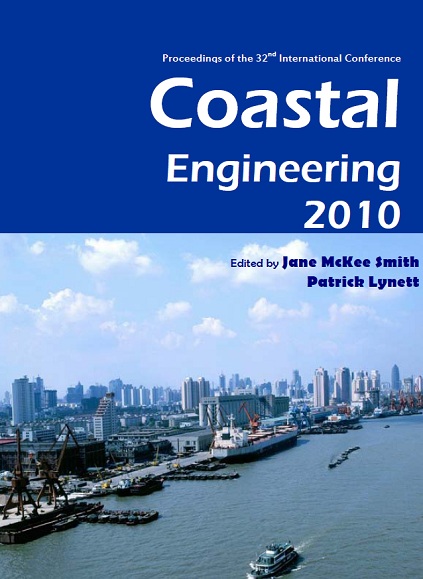Abstract
Determining the largest wave height, H which can occur in water of depth, d without breaking is a fundamental reference quantity for the design of coastal structures. Current design guidelines, used to predict the ratio of breaking height to depth (Hb/d), also known as the breaker index, are based on investigations which predominantly used monochromatic waves, thereby implicitly neglecting group effects. Groupiness or height modulation in wave trains is an inherent characteristic of freely propagating waves in deep water and has been shown within previous studies to induce breaker indices substantially exceeding those predicted by design guidelines. Additionally, the raw data upon which present design guidelines have been based exhibit considerable scatter. This scatter is surprising given the monochromatic and uniform nature of the laboratory waves. A physical investigation at the Water Research Laboratory using new techniques for data extraction and visualisation has yielded new insights into the shoaling and breaking processes of regular and grouped waves and revealed deficiencies in the present design techniques. Monochromatic waves trains were found to develop amplitude modulation with distance along the flume due to non-linear instabilities. These instabilities are well recognized in deep-water waves and contribute to group development and the occurrence of low-probability extreme waves. These modulations induced variation in breaking wave heights, locations and derived breaker indices. Such modulation of initially regular wave trains is proposed as a possible cause of the scatter observed in raw laboratory breaker index data. Wave group testing has revealed evolutionary cycles in local energy density during deep water propagation and that the spatial phasing of this evolution with the initiation of shoaling yielded considerably different shoaling and breaking regimes. Critically, smaller waves within the group, particularly those occurring at the front of the wave group were, at times, able to propagate into shallower water before breaking than is presently predicted by existing design guides. Causes for this discrepancy, including differences in definitions of water level and depth are investigated. However, discrepancies between observed and predicted values are found to remain. Revision to present design guidelines to directly incorporate non-linear group effects and group-induced water level variation are presented.References
Baldock, T. E. (2006). Long Wave Generation by the Shoaling and Breaking of Transient Wave Groups on a Beach. Proc. R. Soc. A. 462, 1853-1876.
Baldock, T. E., P. Holmes and D. P. Horn (1997). Low frequency swash motion induced by wave grouping. Coastal Engineering 32: 197-222. http://dx.doi.org/10.1016/S0378-3839(97)81750-4
Banner, M. L. and W. L. Peirson (2007). Wave Breaking Onset and Strength for Two-Dimensional Deep Water Waves. J. Fluid Mech. 585: 93-115. http://dx.doi.org/10.1017/S0022112007006568
Benjamin, T. B. and J. E. Feir (1967). The disintegration of wave trains on deep water. Part 1: Theory. J. Fluid Mech. 27(3): 417-430. http://dx.doi.org/10.1017/S002211206700045X
Goda, Y. (1970). A Synthesis of Breaker Indices. Transactions of JSCE 2(2): 227-230.
Goda, Y. (2000). Random Seas and Design of Maritime Structures. Singapore, World Scientific Publishing Co. Pte. Ltd.
Goda, Y. (2007). Reanalysis of regular and random breaking wave statistics. 54th Japanese Coastal Engineering Conference.
Longuet-Higgins, M. S. and R. W. Stewart (1962). Radiation stress and mass transport in gravity waves, with application to 'surf beats'. J. Fluid Mech. 13: 482-504. http://dx.doi.org/10.1017/S0022112062000877
Longuet-Higgins, M. S. and R. W. Stewart (1964). Radiation stress in water waves, a physical discussion with application. Deep-Sea Research 11: 529-563.
Munk, W. H. (1949). Surf beats. Trans. Am. Geophys Union 30: 849-854.
Nielsen, P. and Baldock, T.E. (2010). И-Shaped surf beat understood in terms of transient forced long waves. Coastal Engineering, 57: 71-73. http://dx.doi.org/10.1016/j.coastaleng.2009.09.003
Ruessink, B. G. (1998). Infragravity Waves in a Dissipative Multiple Bar System. Utrecht University, The Netherlands: 245.
Shand, T. D., W. L. Peirson and R. J. Cox (2008). On the influence of wave groups on shoaling and breaking waves. ICCE 2008, Hamburg, ASCE. PMCid:2713687
Svendsen, I. A. and J. Veeramony (2001). Wave Breaking in Wave Groups. Journal of Waterway, Port, Coastal and Ocean Engineering July/August, 2001: 200 - 212. http://dx.doi.org/10.1061/(ASCE)0733-950X(2001)127:4(200)
USACE (2003). Coastal Engineering Manual. 1110-2-1100, U.S. Army Corps of Engineers, Washington, D.C. (in 6 volumes).
Weggel, J. R. (1972). Maximum Breaker Height. Journal of the Waterways, Harbours and Coastal Engineering Division 98: 529-548.

